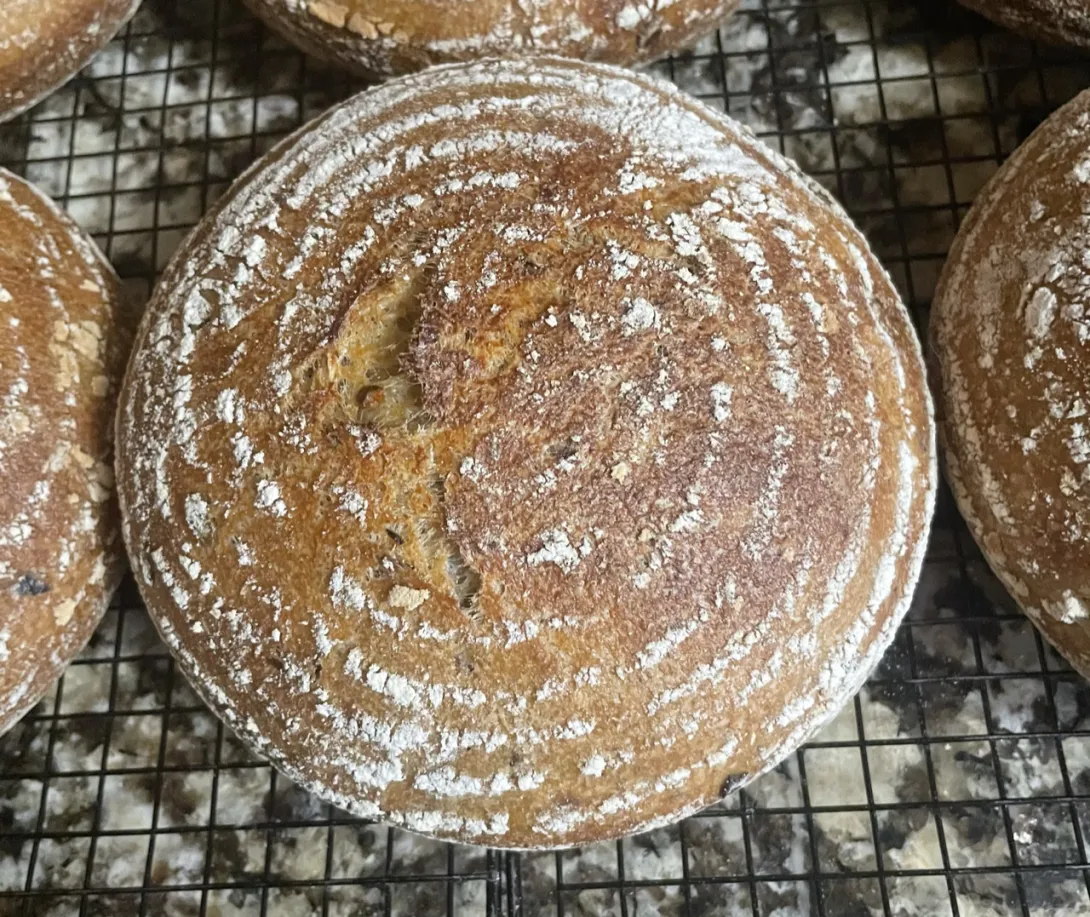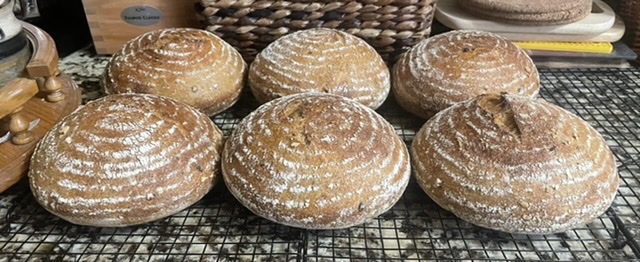
These were a huge hit the last time I made these. However, I forgot that this dough is very loose. When doing a single set of coil folds, keep at it until the dough tightens up. For example, it took 4 rotations of 90 degrees each to get the dough to firm up on most sets of coil folds.
I also did another coil fold just before dividing to give the dough a bit more structure.
Recipe
Makes 3 loaves
Add ins:
150 g Sardo Olive Bruschetta, undrained
100 g Sardo Sweet Pepper Bruschetta, undrained
Main dough:
700 g Strong Bakers Flour
200 g freshly milled Selkirk flour
100 g freshly milled Spelt flour
700 g filtered water
20 g pink Himalayan salt
250 g levain (procedure in recipe)
Extra wholegrain and unbleached flour for feeding the levain
The afternoon before:
1. Take 2 g of refrigerated starter and feed it 4 g of filtered water and 4 g of any kind of wholegrain flour. Let sit at cool room temperature for about 8 hours.
The night before:
1. Mill the Selkirk wheat and Spelt berries and place the required amount in a tub.
2. Add the unbleached flour to the tub. Cover and reserve.
3. Feed the levain 20 g of water and 20 g of wholegrain flour. Let that rise at cool room temperature overnight.
Dough Making day:
1. Feed the levain 100 g of filtered water and 50 g each of wholegrain and unbleached flour. Let rise in a warm spot until doubled (about 4 or 5 hours).
2. Two hours before the levain is ready, put 700 g of filtered water in a stand mixer’s bowl and add the flours from the tub. Mix on the lowest speed until all the flour has been hydrated. This takes a couple of minutes. Cover and autolyse for a couple of hours at room temperature (73F).
3. After the autolyse, add the Olive and Sweet Pepper Bruschettas, the salt, and the levain to the dough.
4. Mix one speed one for a minute or so. Mix on the second speed for 9 minutes.
5. Remove dough from bowl and place in a lightly oiled covered tub. Let rest 30 minutes in a warm spot to begin bulk fermentation. My warm spot is the oven with the door cracked open and the lights on. I get an ambient temperature of around 82F.
6. Do 2 sets of coil folds at 30 minutes intervals and then 2 more sets of coils folds at 45 minute intervals. Then let the dough rise by 30%. This took another 45 minutes.
7. When the dough is ready, give it a final gentle coil fold as this dough is very soft. Tip the dough out on a bare counter, sprinkle the top with flour and divide into portions of ~750 g. Round out the portions into rounds with a dough scraper and let it rest 20-30 minutes on the counter.
8. Do a final shape by flipping the rounds over on a lightly floured counter. Gently stretch the dough out into a circle. Pull and fold the third of the dough closest to you over the middle. Pull the right side and fold over the middle and do the same to the left. Fold the top end to the center patting out any cavities or big bubbles. Finally stretch the two top corners and fold over each other in the middle. Roll the bottom of the dough away from you until the seam is underneath the dough. Cup your hands around the dough and pull towards you, doing this on all sides of the dough to round it off. Finally spin the dough to make as tight boule as you can.
9. Sprinkle a mix of rice and all purpose or baker’s flour in the bannetons. Place the dough seam side down in the bannetons. Cover with plastic bowl covers or shower caps. Let rest for a few minutes on the counter and then put to bed in a cold (38F) fridge overnight. (Try to keep the final proof under 12 hours and preferably closer to 10. I overproofed these the last time when I let them go 13+ hours.)
Baking Day
1. The next morning, heat the oven to 475 F with the Dutch ovens inside for an hour.
2. Turn out the dough seam side up onto a cornmeal sprinkled counter. Place rounds of parchment paper in the bottom of the pots, and carefully but quickly place the dough seam side up inside.
3. Cover the pots and bake the loaves at 450 F for 25 minutes, remove the lids, and bake for another 22 minutes at 425 F. Internal temperature should be 205 F or more.
Well like the last time I made these, these did not get the oven spring I expected. They are pretty flat. Maybe I need to drain the oil out before adding the olives and peppers to the dough. There won’t be a crumb shot unfortunately as these are all sold.

- Danni3ll3's Blog
- Log in or register to post comments
Are those inclusions bottled in oil Danni? If they are do you think it is the oil since you used them undrained that caused the dough to be very relaxed?
Benny
Yes, they are in a jar. I’ll have to try draining the oil next time.
Since peppers are the only thing that will grow in the summer here in Phoenix I’m trying to get a whole bunch of them going but the seeds are sprouting poorly. Of the 8 kinds I’m trying to sprout., only 2 have come up. I don’t I’ll try this one if I ever get them to actually grow!
happt baking Dannu
I got one of those Aerogarden things and I find they are great for starting plants. Mine is just a small one but with the germination kit, I can start 31 plants. So you might want to look into something like that for your peppers.
The recipe above uses a jarred preparation so it might not be the best recipe for your peppers and I need to figure out how to get better oven spring with this one. The Old cheddar, jalapeño with chives that I posted recently might be a better fit. They both taste amazing.